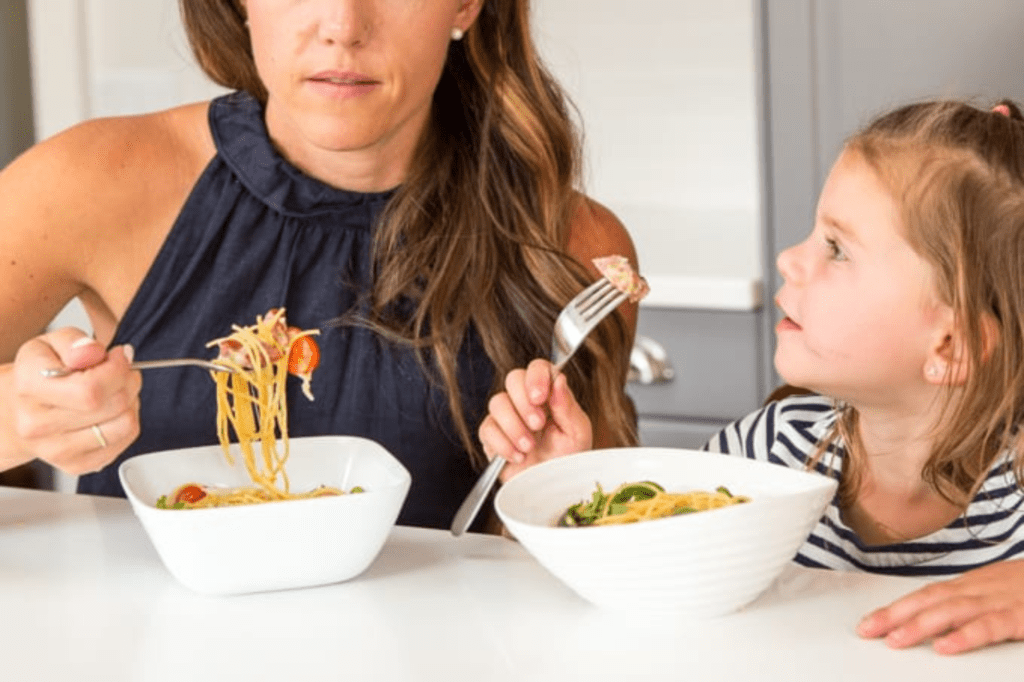Advice from a dietitian mom on how to raise your child to be an intuitive eater, who trusts their body first and foremost when it comes to food.

As a registered dietitian who specializes in childhood nutrition (and a mom of 3 myself), I’m passionate about Intuitive Eating and teaching parents the importance of raising intuitive eaters who have a positive relationship with food and body. I’m sure you’ve heard this term, and perhaps have even read the book Intuitive Eating or began your own journey to becoming an intuitive eater yourself.
Intuitive Eating for Kids
If you’re reading this, my suspicion is that you’re curious about how this philosophy applies to kids and the benefits it may offer your child and your family (particularly at mealtimes). For that, you should feel really good (and proud of yourself), because these learnings will benefit your child (and your children’s children) greatly, and even help to shift generational patterns and beliefs that are deeply rooted in diet culture, and move them more towards food freedom, and body acceptance and positivity.
But, if this is a new concept for you, Intuitive Eating is an evidenced-based, mind-body health approach, comprised of 10 Principles and was created by two dietitians, Evelyn Tribole and Elyse Resch. Intuitive Eating is a weight-neutral and non-diet approach to eating that helps to create more body awareness, and teaches people to truly listen to and honour their physical hunger cues. What’s really cool is that your kids were BORN intuitive eaters. Right from day one, they drank milk purely based on their hunger and fullness. They communicated when they were hungry (with fussing, sucking, rooting etc.) and communicated when they were full (by unlatching, turning their head, stopping to suck etc.). The same was true when they started solid foods! For the most part, until the preschool years, kids eat almost 100% according to their natural hunger and fullness cues. (Curious about your hunger scale? Learn more here.)
Where the waters get muddier is when they get a little bit older (around four-years-old) and their eating influence shifts from purely internal to more external. They may start to eat because food is present, their sibling or friend is eating, because they’re sad, out of boredom, or because they see something yummy on TV. You can likely see how these external influences continue to impact our eating patterns as we get older… enter: emotional eating, social pressures to eat, mindless eating, etc.
Here’s why this is important: We all want our kids to have a healthy relationship with food. We want to prevent disordered eating, chronic dieting and unhealthy pre-occupations with food. We want our kids to grow to love a variety of foods and trust their bodies first and foremost to tell them how much to eat. We want our kids to be able to practice gentle nutrition day-to-day but also indulge in not-so-healthy foods occasionally and mindfully without going completely overboard too.
3 Steps For Mindful Eating
If there’s anything that I suggest you focus on right now food-wise with your kids, make it about building their healthy long-term relationship with food. Because Intuitive Eating is a complex model and can be a bit overwhelming, I’ve broken it down into three simple steps you can take with your kids while you’re at home with them:
- Ditch Your Mealtime Agenda
- Make it more about family time and less about “get my kid to eat time”
- Close the kitchen after meals and snacks
Let’s dive into these steps for mindful eating (or click the link above to jump to that section).
Ditch your Mealtime Agenda
If you find yourself feeling anxious before or during a meal with your kids, pressuring them to eat more or less of any certain food, or having a specific “right” amount of food that you feel your child should eat, you’re not alone.
But here’s the thing: it’s actually NOT your job to get your kid to eat.
It IS your job to provide nutritious meals and snacks every day, at times and in places that you choose. But when it comes to if and how much your child eats? That’s 100% up to them. Establishing these feeding roles early takes the pressure off of everyone.
As mentioned above, kids are born intuitive eaters – they will finish eating when they’re full and (most of the time) they will eat when they are hungry. When given a set meal and snack schedule (which I talk more about below) where food is offered in a positive and pressure-free way, kids will either eat the food provided (or not), and learn to eat in amounts that are right for their bodies. This is called “self-regulation”. If, as parents, we’re always trying to control if and how much our kids eat (we ALL do this), our kids will learn NOT to trust their bodies, and instead to trust external cues more often.
In order to do this, we really do need to create a pressure-free environment at meals. You serve a balanced meal with at least ONE considerate food (a food that you think your child will accept) and then, it’s hands off. Focus on your own meal, and keeping the tone positive. If issues arise (special requests, complaining, getting up and down from the table, etc.) gently remind your kids of the mealtime boundaries (these are unique for each family), but otherwise, no pressuring, coaxing, bribing, or bartering.
I know… sometimes when we feel defeated and worried (and even desperate), we turn to these strategies in hopes that our kids will eat (eat anything!), but unfortunately, it further perpetuates picky eating tendencies, mealtimes battles and unhealthy eating habits. Encourage your child to listen to their tummy (below is a hunger scale that you can use with your child) and show them that you trust THEM to trust their own body.
A Child’s Hunger Scale
Make it more about family time and less about “get my kid to eat time”
Parents often dread mealtimes because they foresee a struggle from beginning to end. We’re already anxious enough these days, but anticipating a stressful meal with kids can create even more anxiety, and our kids feed off of this (excuse the pun!). In our efforts to control the situation, we may use phrases like
- “It’s dinner time—come to the table and eat!”
- “You’re not getting down from this table until you eat something!”
- “Please try your peas—they are good for you!”
- “Please just eat–at least one bite!”
- “You can’t have dessert unless you have at least 5 bites of your meal” or
- “No you cannot have more bread—you’ve hardly touched your vegetables or meat!”
Although we as parents have the best intentions, and are just trying to do our job, we often enable picky eating and create unneeded power struggles by putting all of the focus on food and getting your child to eat.
Mealtimes don’t have to bring on anxiety and dread if you can master the art of… backing off.
Take the pressure off (both yourself and your child) to make mealtimes more peaceful. This can be really (ahem… excruciatingly) hard, especially if you feel that your child isn’t eating well daily. Over time, taking the focus off of the food, and focusing more on positive family time, makes your child feel at ease and gives her space to try new foods on her own and eat according to her physical hunger.
Close the kitchen after meals and snacks
After a meal or snack, it’s important to make sure that your kids know that the kitchen is closed. This is a mealtime boundary that I encourage ALL parents to put into place, and one that I practice myself with my own kids.
What this means is:
- No snacks right after dinner
- No alternate meal served after the family meal was rejected
- No grazing on the food that’s leftover on their plate from dinner
- No glasses of milk because they didn’t eat enough
At first, if it’s been a bit of a food free-for-all in your house, there will likely be resistance (and whining and crying) but over time, your kids will learn how to self-regulate, and eat enough to feel comfortably full after meals. Compassion is key here, for both your kids and yourself.
If I have a hunch that my kids haven’t eaten enough, I remind them that it’s a good idea to make sure their tummies have finished eating because the kitchen will be closed after mealtime. Requests or demands for snacks outside of these times are gently turned down, with a kind reminder that they had a chance to eat at the last meal or snack, and they chose not to, but there will be another opportunity in a few hours (or the next morning).
But, isn’t this contrary to Intuitive Eating?
Some parents question this with “but isn’t Intuitive Eating all about eating according to your natural hunger cues?” or “What if they aren’t hungry at a meal, but half an hour after they want a snack? Aren’t I DISCOURAGING Intuitive Eating by turning down snack requests when they’re hungry?”
All good questions and valid concerns. And yes, for adults, Intuitive Eating means eating according to your natural hunger cues, tuning into your body and trusting it. But kids don’t yet have the ability to self-regulate the way adults know how to. The choice to eat or not often is made out of preference, and tend to have more concrete thinking patterns, rather than nuanced, abstract thinking.
For example, they may think “That meat and those veggies don’t look yummy, so I’ll just have my piece of bread (safe food) and then wait until after dinner and ask for cereal, because I know I’ll get it”. Whereas an adult might think “ok, so it’s not my favourite food, but I’ll eat enough so that I’m satisfied and have energy for the next 3-4 hours until dinner.”
Kids need some structure and boundaries around food timing so that they can learn to sit and eat until their “tummy is done” (which hopefully means they eat until their comfortably full) and then have time to work up an appetite for the next eating time.
When parents offer a variety of foods at meals and snacks (again, with at least one considerate food), and then let their child decide which foods (and how much) they’ll eat, you’re setting the stage for intuitive eating long term. It’s sort of like a sleep schedule. Babies and toddlers need some guidance and structure for nap times and bedtime in order to get enough sleep.
Trust your Intuition as the Parent
In saying this, we all know that every parenting strategy is nuanced and requires a bit of flexibility. So, if you know that your child isn’t feeling well, you may offer a bit more flexibility around not having to come to the table for meals and snacks and just resting and focusing on fluids. The same is true if you notice that your child is going through a period of rapid growth. Perhaps even after eating a full meal, they are still hungry an hour later and it’s appropriate to offer more food. Use YOUR intuition and best judgement as the parent.
About the author: Sarah Remmer is a registered dietitian and mom of 3 based in Calgary, AB, the co-author of the book Food to Grow On: The Ultimate Guide to Childhood Nutrition, From Pregnancy to Packed Lunches, and Founder and President of The Centre for Family Nutrition, a Canadian Nutrition counselling practice. You can find Sarah on Instagram (@sarahremmer) and on her blog: sarahremmer.com








Leave a Comment & Rate this Recipe